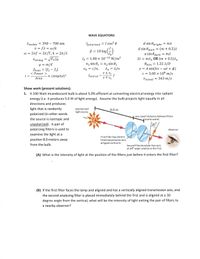Question

Transcribed Image Text:WAVE EQUATIONS
= I cos? 0
Avisible
v = f1 = w/k
w = 2nf = 2n/T, k = 21/A
= 390 – 700 nm
d sin Opright = m1
(т + 0.5)1
Ipoiarized
d sin Odark =
B = 10 log
a sin Odark
= m.
I, = 1.00 x 10-12 W/m²
2t %3D тлn OR (т + 0.5)Л.
Vstring = /Fr/µ
H = m/e
fbeat = If2 – fil
< Power >
n1 sin 01 = n2 sin 02
Omin
= 1.22 1/D
An = 1/n
v±v.
f
v 7 vs
y = A sin(kx – wt + 4)
c = 3.00 x 108 m/s
Vn = c/n,
I
« (Атpltd)2
fshifted
%3|
Area
Vsound - 343 m/s
Show work (present solutions).
1. A 100 Watt incandescent bulb is about 5.0% efficient at converting electrical energy into radiant
energy (i.e. it produces 5.0 W of light energy). Assume the bulb projects light equally in all
directions and produces
light that is randomly
Unpolarized
light source
8.0 m
polarized (in other words
the source is isotropic and
very small distance between filters
(not to scale)
unpolarized). A pair of
30
polarizing filters is used to
Observer
examine the light at a
First filter has electric
position 8.0 meters away
field transmission axis
alligned vertically.
from the bulb.
Second filter/analyzer has axis
at 30° angle relative to the first.
(A) What is the intensity of light at the position of the filters just before it enters the first filter?
(B) If the first filter faces the lamp and aligned and has a vertically aligned transmission axis, and
the second analyzing filter is placed immediately behind the first and is aligned at a 30
degree angle from the vertical, what will be the intensity of light exiting the pair of filters to
a nearby observer?
Expert Solution
This question has been solved!
Explore an expertly crafted, step-by-step solution for a thorough understanding of key concepts.
This is a popular solution
Trending nowThis is a popular solution!
Step by stepSolved in 2 steps with 1 images

Knowledge Booster
Similar questions
- Suppose you want to rotate the plane of polarization of a beam of polarized light by 67°, but you do not want the final intensity to be less than 88% of the initial intensity. What is the minimum number of polarizing sheets you must use? Assume that each sheet is rotated the same angle relative to the adjacent sheets.arrow_forwardA beam of unpolarized light of intensity 4.04E3 W/m2 passes through a series of ideal polarizing filters with their polarizing directions turned to various angles as shown in the figure. If the middle polarizer is removed, what is the light intensity at point C (in W/m2)?arrow_forwardA beam of unpolarized light of intensity 2.17E3 W/m2 passes through a series of ideal polarizing filters with their polarizing directions turned to various angles as shown in the figure. What is the light intensity at point C (in W/m2)? Use 3 sig figs and scientific notationarrow_forward
- The axes of a polarizer and an analyzer are oriented at 30° to each other. (a) If unpolarized light of intensity I is incident on them, what is the intensity of the transmitted light? (b) Polarized light of intensity I is incident on this polarizer-analyzer system. If the amplitude of the light makes an angle of 30° with the axis of the polarizer, what is the intensity of the transmitted light?arrow_forwardUnpolarized light passes through two ideal polarizers in turn with polarization axes at 43.9° to each other. What is the fraction of the incident light intensity that is transmitted?arrow_forwardAn unpolarized beam of light with an intensity of 5000 W/m2 is incident on two ideal polarizing sheets. If the emerging light has an intensity 0.200 times the original intensity of the incident beam, what is the angle between the two polarizers?arrow_forward
- Vertically polarized light of intensity lo is incident on a polarizer whose transmission axis is at an angle of 70° with the vertical. If the intensity of the transmitted light is measured to be 0.34W/m², the intensity lo of the incident light is O 1.71 W/m2 O 0.99 W/m² O 0.43 W/m2 O 2.91 W/m²arrow_forwardYellow light with wavelength 600nm propagates in the +x direction. The wave is linearly polarized along the ±y direction. a) Draw a labeled snapshot mode picture of what the electric and magnetic fields look like. Use vector representation. b) Determine the frequency of oscillation of the electric field vector for the yellow light. Is the magnitude of this frequency very large or very small?arrow_forwardUnpolarized light with intensity Io is incident on a series of polarizing sheets. The first sheet has itstransmission axis oriented at 90°. A second polarizer has its transmission axis oriented at 60° .Determine the fraction of light intensity exiting the second sheet?arrow_forward
arrow_back_ios
arrow_forward_ios